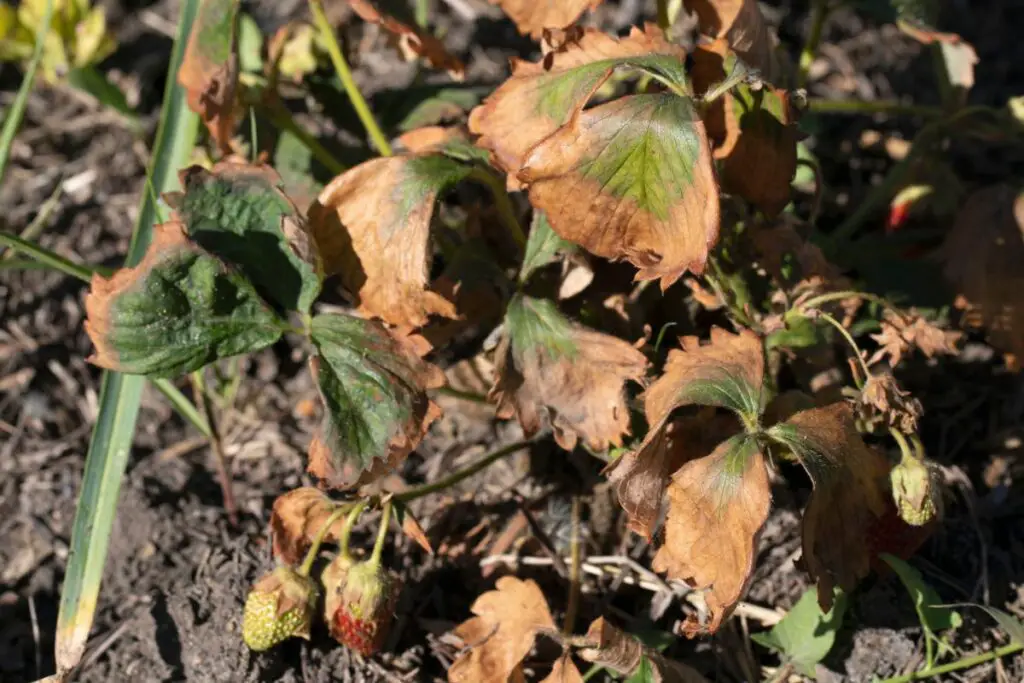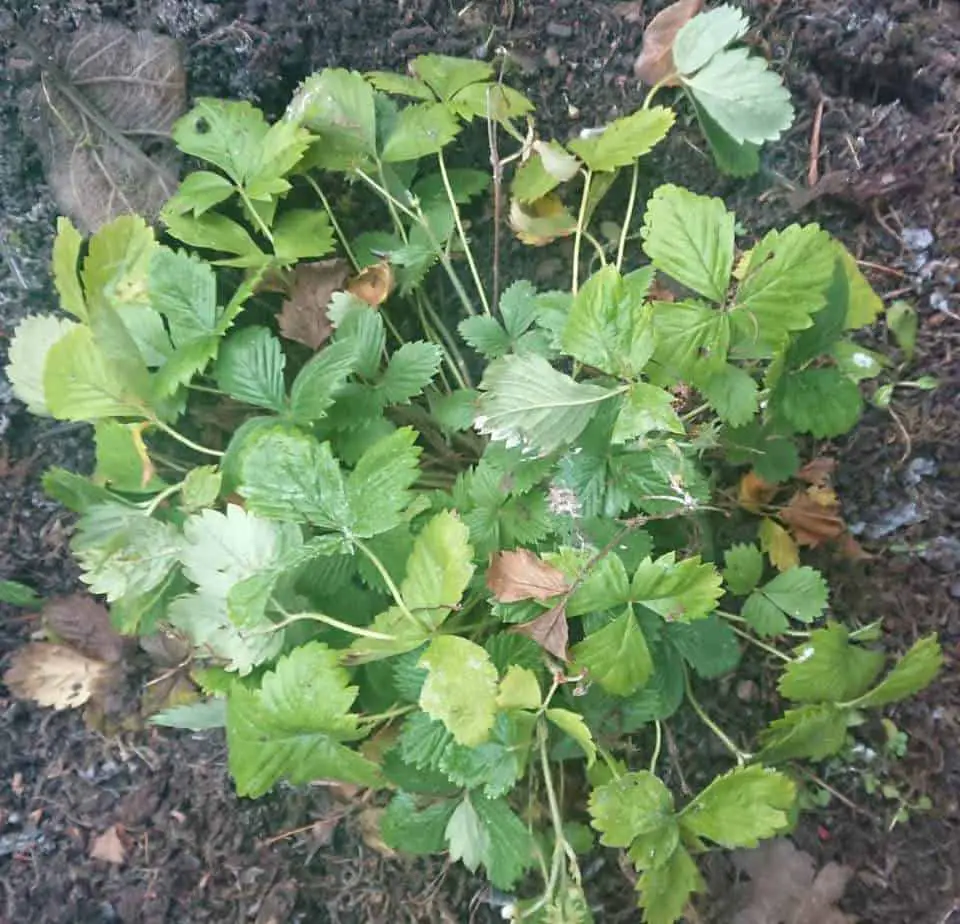Determining the fate of a strawberry plant can be a perplexing task, especially for those with limited horticultural knowledge. In this article, you will be guided through the intricate process of distinguishing between a prized, thriving strawberry plant and one that has met its unfortunate demise. With a keen eye for signs of life, an understanding of plant physiology, and a basic understanding of common pitfalls, you will find yourself equipped with the knowledge needed to confidently assess the vitality of your strawberry plant. Get ready to unravel the mystery and decode the language of the botanical world.
| Criteria | Healthy Signs | Unhealthy Signs | Notes/Actions |
|---|---|---|---|
| Appearance of the Plant | Vibrant green leaves, sturdy stems | Wilting, brown/black leaves, mushy or dry stems | Ensure proper watering and check for diseases |
| Soil Conditions | Moist, well-drained soil | Waterlogged, dry, presence of mold or fungus | Adjust watering habits, consider soil amendments |
| Root Health | White or light-colored roots, firm texture | Dark, mushy, or rotten roots | Consider repotting or improving drainage |
| Plant Behavior | New shoots, consistent growth, flower production | Absence of new growth, stunted growth, no flowers | Check for environmental stress factors |
| Inspecting the Crown | Firm, green, and healthy appearance | Dark, shriveled, soft, or rotten crown | Crown health is crucial; if damaged, recovery may be hard |
| Damage from Pests | No visible damage, healthy foliage | Bite marks, droppings, presence of larvae or pests | Employ organic or recommended pest control methods |
| Disease Symptoms | No discoloration or spots | Yellowing, browning, spots, lesions on leaves | Employ disease control methods, possibly prune affected areas |
| Lack of Response to Reviving | Recovers after pruning or other interventions | No change or further deterioration after interventions | Consult a horticulturist |
| Comparison to Healthy Plants | Similar vigor, color, and growth as other healthy plants | Pale, discolored, weaker compared to healthy plants | Analyze and replicate the conditions of healthy plants |
| Horticulturist Opinion | Confirmation of health or guidance for improvement | Diagnosis of serious health issues or confirmation of demise | Provide detailed info, consider expert recommendations |
Appearance of the Plant
When assessing the health of a strawberry plant, one of the first visual cues to consider is the condition of its leaves. Wilting leaves can indicate a lack of water, while brown or blackened leaves may suggest a more serious problem, such as disease or nutrient deficiencies. Additionally, a mushy stem can be a sign of root rot or excessive moisture, while dry and brittle leaves may indicate dehydration or nutrient imbalances. Another noticeable symptom to look out for is limpness in young foliage, which can be an indication of a lack of essential nutrients or poor root health.
Soil Conditions
The soil in which a strawberry plant is growing plays a crucial role in its overall health and vitality. Waterlogged soil, saturated with excess moisture, can have detrimental effects on the plant’s roots by depriving them of necessary oxygen. On the other hand, dry and cracked soil can signify inadequate watering or a lack of moisture retention. Additionally, the presence of fungus or mold in the soil can be an indication of root rot or other fungal infections, which can severely impact the plant’s longevity and productivity.

Root Health
The health of a strawberry plant’s roots is a fundamental aspect of its overall well-being. Inspecting the roots can provide valuable insights into the plant’s condition. Root discoloration, characterized by a dark or brown appearance, can be a sign of disease or root damage. Likewise, root mushiness indicates rot and decay, which can be caused by overwatering or poor drainage. Another concerning sign is the lack of new growth from rhizomes, the underground stems responsible for producing new shoots. If the rhizomes appear dormant or inactive, it may suggest that the plant is struggling to sustain its growth and health.
Plant Behavior
Observing the behavior of a strawberry plant can be another crucial factor in determining its vitality. The absence of new shoots, characterized by a lack of new growth emerging from the crown, can be a clear indication that the plant is not thriving. Stunted growth, where the plant fails to reach its expected size or dimensions, may suggest nutrient deficiencies or environmental stress. Furthermore, a lack of flower production, despite the presence of healthy foliage, could be a sign of inadequate pollination, nutrient imbalances, or even hormonal disruptions within the plant.
Inspecting the Crown
The crown of a strawberry plant, where the stem and roots meet, can provide valuable information about its current state. A darkened crown, often accompanied by a shriveled or withered appearance, can signify poor health or disease. Similarly, a soft or rotten crown is a clear indication of decay and can be caused by excessive moisture or fungal infections. In severe cases, the crown may become disconnected from the roots, leading to the plant’s complete demise as it loses its ability to uptake essential nutrients and water.
Damage from Pests
Pests can pose a significant threat to the health and survival of strawberry plants. Evidence of insect infestation, such as visible bite marks on the leaves or the presence of pest droppings, can indicate an ongoing pest problem. Moreover, the discovery of larvae or eggs on the plant can imply a more severe infestation that may require immediate intervention. Indications of rodent activity, such as chewed leaves or dug-up soil, can also suggest the presence of pests that may compromise the plant’s health and well-being.
Disease Symptoms
Diseases can afflict strawberry plants and cause visible symptoms that indicate their presence. Browning or yellowing leaves can be a sign of various diseases, including fungal infections or viral diseases. Likewise, the presence of visible lesions or spots on the leaves can indicate a disease or pest damage. Despite adequate watering, wilting can occur if the plant is infected with certain diseases that disrupt its normal water balance and uptake, leading to dehydration and overall decline.
Lack of Response to Reviving Methods
To salvage a seemingly struggling strawberry plant, gardeners often resort to pruning or transplantation. However, if the plant fails to exhibit any positive response to these reviving methods and continues to deteriorate, it may suggest that the plant is beyond the point of recovery. If there is no visible change in the plant’s condition after pruning or if it fails to recover following transplantation, it is often a clear indication that the plant is dead or in an irreversible state of decline.

Comparison to Healthy Strawberry Plants
Comparing the characteristics of a potentially dead strawberry plant to those of healthy strawberry plants can provide additional insights into its health status. Growth differences, such as a lack of vigor or slower growth compared to healthy plants, can indicate underlying problems. Moreover, differences in leaf colors, such as a pale or discolored appearance, can be a sign of nutrient deficiencies or disease. Evaluating the overall vigor and strength of the plant in comparison to healthy counterparts can help confirm its poor health or potential demise.
Second Opinion from Horticulturist
When in doubt about the health and viability of a strawberry plant, seeking a second opinion from a horticulturist or local gardening expert can be immensely valuable. Consulting an expert can provide a more accurate assessment of the plant’s condition and potential courses of action. To obtain the most helpful advice, it is crucial to provide the horticulturist with detailed information about the plant’s symptoms, soil conditions, watering practices, and any recent changes that may have affected its health. Additionally, an expert plant examination can offer deeper insights into the plant’s overall health and potential for recovery.



